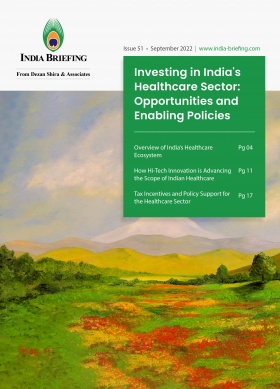India’s Union Budget for 2023-24: Key Highlights
India’s Union Budget 2023-24, announced February 1, promotes infrastructure growth, green industry, and makes changes to the new tax regime. We report the major highlights.
India’s Finance Minister Nirmala Sitharaman announced the Union Budget for 2023-24 on February 1, following the release of the Economic Survey of India 2023 at the start of the Budget Session of the parliament.
This is the last full federal budget presented by the current Narendra Modi-led government before the general elections scheduled for 2024. Nine states will hold elections in the run up to the general elections.
As per The Economic Survey 2023, tabled January 31, India’s economic revival after the COVID-19 pandemic is complete. India’s GDP growth (in real terms) is expected to stay strong in FY 2022-23 at 7 percent and growth is projected to be in the 6 to 6.8 percent range for FY 2023-24.
The projection of India’s FY24 GDP growth is higher than the 6.1 percent estimate of the International Monetary Fund (IMF) but will depend on the trajectory of economic and political developments globally.
State of the Indian economy
Highlights of the Union Budget 2023-24
The following are key themes permeating this latest budget – continued push for fiscal prudence, green growth and achieving net zero emissions targets, export-oriented production, infrastructure advancement and modernization, 5G services and support for new applications and research, upskilling, and relief for the middle-class taxpayer.
Fiscal deficit
Proposed fiscal deficit for FY 2023-24 is 5.9 percent of the GDP, towards achieving the 4.5 percent target by FY 2025-26 as the government is prioritizing fiscal consolidation.
The state fiscal deficit target is set at 3.5 percent, of which 0.5 percent is conditional to certain targets like power sector reforms.
Sitharaman noted that “to finance the fiscal deficit in 2023-24, the net market borrowings from dated securities are estimated at INR 11.8 trillion. The balance financing is expected to come from small savings and other sources. The gross market borrowings are estimated at INR 15.4 trillion.”
Green economy
Recently launched, the National Green Hydrogen Mission, has a an outlay of INR 197 billion, and will facilitate the transition of the Indian economy to low carbon intensity, reduce fossil fuel imports, and enable India to achieve technology and market leadership in this sunrise sector. The government has set a target to reach an annual production of 5 MMT by 2030.
The budget provides INR 350 billion for priority capital investments towards energy transition and net zero objectives, and energy security by the Ministry of Petroleum & Natural Gas.
The budget announced that battery energy storage systems with capacity of 4,000 MWH will be supported with viability gap funding. A detailed framework for pumped storage projects will also be formulated.
The customs duty exemption has been extended to the import of capital goods and machinery required for the manufacture of lithium-ion cells for batteries used in electric vehicles.
The budget also announced the construction of an inter-state transmission system for evacuation and grid integration of 13 GW renewable energy from Ladakh at an investment of INR 20,700 crore, of which central government spend will be INR 83 billion.
A Green Credit Program is also being proposed and will be notified under the Environment (Protection) Act, to incentivize environmentally sustainable and responsive actions by companies, individuals, and local bodies.
The budget announced 500 new ‘waste to wealth’ plants under the GOBARdhan (Galvanizing Organic Bio-Agro Resources Dhan) scheme to promote the circular economy. These will include 200 compressed biogas (CBG) plants, including 75 plants in urban areas, and 300 community or cluster-based plants at a total investment of INR 100 billion.
Infrastructure
The central government has proposed a INR 10 trillion capital expenditure outlay for FY 2023-24, which is a 33 percent increase year-on-year and 3.3 percent of the GDP.
“The direct capital investment by the Centre is complemented by the provision made for creation of capital assets through Grants-in-Aid to States. The ‘Effective Capital Expenditure’ of the Centre is budgeted at 13.7 trillion, which will be 4.5 per cent of GDP.”
The proposed capex outlay for railways is INR 2.4 trillion – nine times the outlay proposed in 2013-14 and the highest ever according to the finance minister.
For FY 2023-24, state governments will benefit from the 12-month extension on the 50-year interest-free loans to aid infrastructure investments. The outlay for this is INR 1.3 trillion. This initiative began in the Union Budget for FY 2020-21 after the COVID-19 pandemic struck. Called the ‘Scheme for Special Assistance to States for Capital Investment’, the central government provided 50-year interest-free loans to state governments worth INR 118.30 billion in FY 2020-21 and INR 141.86 billion in FY 2021-22.
Sitharaman stated:
“The entire fifty-year loan to states has to be spent on capital expenditure within 2023-24. Most of this will be at the discretion of states, but a part will be conditional on states increasing their actual capital expenditure. Parts of the outlay will also be linked to, or allocated for, the following purposes:
- Scrapping old government vehicles;
- Urban planning reforms and actions;
- Financing reforms in urban local bodies to make them creditworthy for municipal bonds;
- Housing for police personnel above or as part of police stations;
- Constructing Unity Malls [for promotion and sale of state-ODOPs (one district, one product), GI products, and other handicraft products];
- Children and adolescents’ libraries and digital infrastructure; and
- State share of capital expenditure of central schemes.”
The budget also mentioned a Harmonized Master List of Infrastructure, which will be reviewed by an expert committee to recommend the classification and financing framework suitable for India’s growth trajectory achieved by 100 years of independence or Amrit Kaal.
Logistics
To improve logistics, 100 critical transport infrastructure projects, for last and first mile connectivity for ports, coal, steel, fertilizer, and food grains sectors have been identified by the government. Sitharaman announced that these will be taken up on priority with investment of about 750 billion, including around 150 billion private capital.
In other logistics infrastructure announcements, Sitharaman has proposed 50 additional airports, heliports, water aerodromes, and revival of advanced landing grounds for boosting regional air connectivity.
The budget also mentioned that coastal shipping will be promoted as the energy efficient and lower cost mode of transport, both for passengers and freight, through public-private-partnership (PPP) mode with viability gap funding.
Urban development
An Urban Infrastructure Development Fund (UIDF) will be set up to be managed by the National Housing Bank and target urban infrastructure in tier-2 and tier-3 cities.
All cities and towns will be enabled for 100 percent mechanical desludging of septic tanks and sewers to transition from manhole to machine-hole mode.
Technology and research
Under the vision of “Make AI in India and Make AI work for India”, three centers of excellence for artificial intelligence (AI) will be set-up in top educational institutions. The government intends for leading industry players to partner in conducting interdisciplinary research, develop cutting-edge applications, and scalable problem solutions in the areas of agriculture, health, and sustainable cities.
A National Data Governance Policy is also in the works to enable access to anonymized data for the benefit of research by start-ups and academicians.
The budget proposes 100 labs for developing applications using 5G services to be set up in engineering institutions to tap into new opportunities, business models, and generate employment. The labs will cover areas, such as smart classrooms, precision farming, intelligent transport systems, and healthcare applications.
For higher education, the budget has proposed setting up 157 new nursing colleges in co-location with the existing 157 medical colleges established since 2014. Research and innovation in pharmaceuticals and medical devices will also be encouraged.
GIFT IFSC
Sitharaman announced the following measures to enhance business activities in GIFT IFSC:
- Delegating powers under the SEZ Act to IFSCA to avoid dual regulation
- Setting up a single window IT system for registration and approval from IFSCA, SEZ authorities, GSTN, RBI, SEBI, and IRDAI
- Permitting acquisition financing by IFSC Banking Units of foreign banks
- Establishing a subsidiary of EXIM Bank for trade re-financing
- Amending the IFSCA Act for statutory provisions for arbitration, ancillary services, and avoiding dual regulation under SEZ Act
- Recognizing offshore derivative instruments as valid contracts
- Extension of period of tax benefits to funds relocating to IFSC, GIFT City till March 31, 2025
Bureaucracy reform
KYC process to be simplified through a ‘risk-based’ approach and not ‘one size fits all’. Financial regulators will be encourage to align their KYC system to the needs of Digital India.
Sitharaman also announced that “a one stop solution for reconciliation and updating of identity and address of individuals maintained by various government agencies, regulators and regulated entities” will be established by expanding DigiLocker service and “using Aadhaar as foundational identity”.
For the business establishments that are required to have a Permanent Account Number (PAN), the PAN will be used as the common identifier for all digital systems of specified government agencies. This will be facilitated via a legal mandate.
A unified filing process is also being proposed to prevent duplication of data submitted to different agencies by allowing the filers choice for data sharing with other agencies.
Governance and investor protection in the banking sector
The budget proposes certain amendments to the Banking Regulation Act, the Banking Companies Act, and the Reserve Bank of India Act to improve bank governance and enhance investors’ protection.
Start-ups
India has the third largest ecosystem in the world for start-ups, and “ranks second in innovation quality among middle-income countries”.
To support entrepreneurship the budget has proposed to extend the date of incorporation for income tax benefits to start-ups from March 31, 2023 to March 31,2024.
Moreover, it is proposed to provide the benefit of carry forward of losses on change of shareholding of start-ups from seven years of incorporation to 10 years.
Capital gains
The government has proposed to cap deductions from capital gains on investments in residential houses under sections 54 and 54F of the Income-tax Act to INR 10 crore. It is also proposed to limit income tax exemption from proceeds of insurance policies with very high value.
No changes made to the long-term capital gains structure.
Personal tax
The major proposal announced under personal income tax is making the new tax regime the default regime, with the old tax regime becoming optional.
Further, all changes related to rebate limits, tax slabs, standard deductions, and surcharge have been announced only for the new tax regime. This is understandable as there have not been many takers of the new tax regime – first announced in Union Budget for FY 2020-21.
The modified income tax slabs under the new income tax regime will be as follows:
1) INR 0 to INR 300,000 – Nil
2) INR 300,000 to 600,000 – 5 percent tax rate
3) INR 600,000 to 900,000 – 10 percent tax rate
4) INR 900,000 to 1.2 million – 15 percent tax rate
5) INR 1.2 million to 1.5 million – 20 percent tax rate
6) Above INR 1.5 million – 30 percent tax rate
The government has also reduced the surcharge of the highest rate from 37 percent (at present) to 25 percent in the new tax regime. Further, it is proposed to extend the benefit of standard deduction in the new tax regime for salaried persons and pensioners, including family pensioners.
Read our coverage on the proposed changes to the new tax system here and comparison with the old tax system.
Comparison Between Amended New Tax Regime and the Old Tax Regime
|
New Tax Regime |
FY 2023-24 |
Old Tax Regime |
FY 2023-24 |
|
INR 0 – 300,000 |
Nil |
INR 0 – 250,000 |
Nil |
|
INR 300,000 – INR 600,000 |
5% |
INR 250,000 – INR 500,000 |
5% |
|
INR 600,000 – INR 900,000 |
10% |
INR 500,000 – INR 1 million |
20% |
|
INR 900,000 – INR 1.2 million |
15% |
INR 1 million and upwards |
30% |
|
INR 1.2 million – INR 1.5 million |
20% |
Those earning up to INR 500,000 per annum are entitled to a rebate. |
|
|
INR 1.5 million and upwards |
30% |
||
|
Those earning up to INR 700,000 per annum are entitled to a rebate. |
|
||
Taxation of MSMEs and professionals
Micro enterprises with annual turnover of up to INR 20 million and certain professionals with turnover of up to INR 5 million can avail the benefit of presumptive taxation. The budget has proposed to provide enhanced limits of INR 30 million [micro enterprises] and INR 7.5 million [professionals] respectively, to taxpayers whose cash receipts are no more than 5 percent.
For MSMEs, the budget has proposed to “allow deduction for expenditure incurred on payments made to them only when payment is actually made.”
Customs duty
Several announcements on basic customs duty (BCD) were made to boost green mobility and mobile manufacturing, with a view to enhance export-oriented production.
Reductions on certain parts and inputs like camera lens is extended for another year.
To promote value addition in the local manufacture of televisions, it is proposed to reduce the BCD on parts of open cells of TV panels to 2.5 percent.
The concessional duty on lithium-ion cells used in battery packs will be continued for another year.
To promote local manufacturing of electric kitchen chimneys, the BCD is being raised from 7.5 percent to 15 percent, while that on chimneys’ heat coil is being reduced from 20 percent to 15 percent.
To promote lab grown diamonds, the budget has proposed to reduce the BCD on seeds used in their manufacture.
The customs duties on articles made from gold and platinum will be increased and import duty on silver dore, bars, and articles will also be increased to align with gold and platinum. Earlier in FY 2022-23, the customs duties had been raised on dores and bars of gold and platinum.
BCD exemption on raw materials for manufacture of CRGO Steel, ferrous scrap and nickel cathode will continue. Also, concessional BCD of 2.5 percent on copper scrap will continue for the benefit of secondary copper producers who are mainly in the MSME sector.
The BCD on compounded rubber is also being raised to be at par with that on natural rubber other than latex, to curb circumvention of duty.
The number of customs duty rates on goods other than agriculture and textiles, has been reduced from 21 to 13. Consequently, there are minor changes in the basic custom duties, cesses, and surcharges on some items, including toys, bicycles, automobiles, and naphtha.
Cigarette tax
Cigarettes will be taxed by about 16 percent. The government had last revised the National Calamity Contingent Duty (NCCD) on specified cigarettes three years ago.
Quick take
When presenting her fifth union budget, Sitharaman said the 2023-24 budget will set the foundation for India at 100 years of independence (Amrit Kaal) – where it becomes a technology-driven economy.
The 2023 union budget contains proposed and forthcoming measures across seven priority areas that are complementary and vital for Amrit Kaal – inclusive development, reaching the last mile, infrastructure and investment, unleashing the potential, green growth, youth power, and the financial sector.
The mood behind this particular budget has been one of optimism. The Indian economy is viewed as ‘a bright star’ amid a global slowdown, outperforming its peers with an estimated 7 percent growth rate in FY 2023 – the highest among emerging economies. In fact, India has jumped to becoming the fifth largest economy in the world from ranking 10th largest in less than a decade.
The finance minister opted for less disruption in this final budget before election year and instead focused on increasing government allocations to crowd in private capital in infrastructure and related projects. Developing potential in the green economy is another clear target for capex outlay and government schemes.
Populism appears to have been foregone to an extent, as the much awaited personal income tax announcement was linked to relief for middle class taxpayers in the new tax regime. Certain specific announcements may be read as targeting upcoming state elections.
About Us
India Briefing is produced by Dezan Shira & Associates. The firm assists foreign investors throughout Asia from offices across the world, including in Delhi and Mumbai. Readers may write to india@dezshira.com for more support on doing business in in India.
We also maintain offices or have alliance partners assisting foreign investors in Indonesia, Singapore, Vietnam, Philippines, Malaysia, Thailand, Italy, Germany, and the United States, in addition to practices in Bangladesh and Russia.
- Previous Article The Netherlands Was India’s Third Largest Export Destination in April-December 2022: Commerce Ministry Data
- Next Article Highlights of the Indian Economic Survey 2022-23










